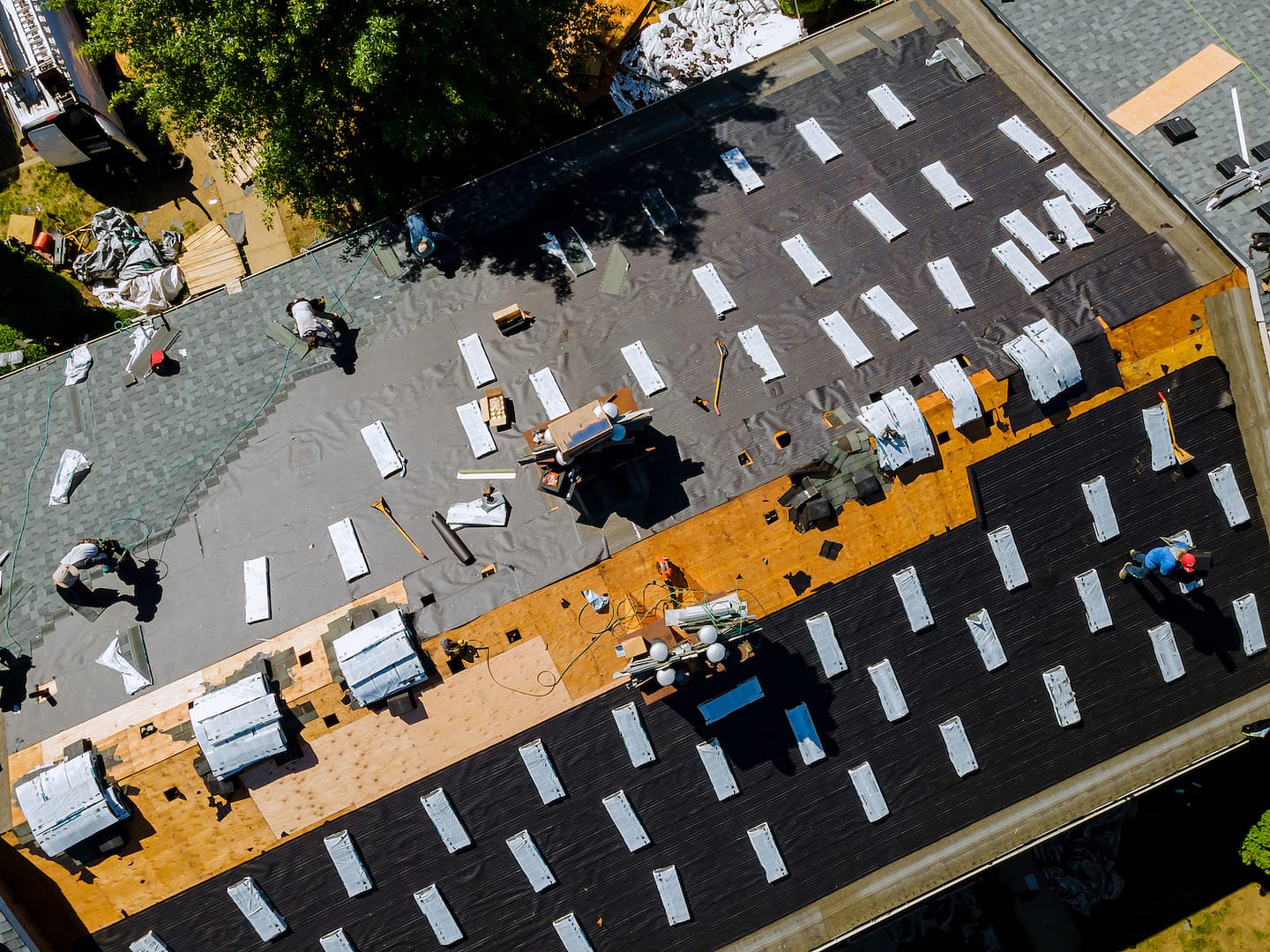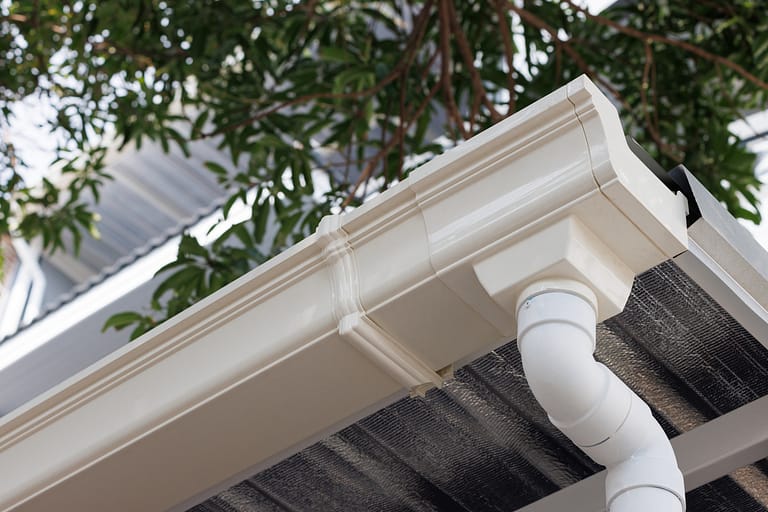Your roof is more than just a cover over your head; it’s your #1 protection for your home and everything inside it. Over time, however, even the most durable roofs can wear down, succumbing to:
- Age 👴🏼
- Weather ⛈️
- Wear and tear 🏚️
When that happens, it’s crucial to embark on the roof replacement process promptly to avoid further damage to your home and ensure its safety and integrity.
In this comprehensive guide, we’ll take you through every step of the roof replacement journey. From recognizing the signs that indicate your roof needs replacing to finding the right contractor, understanding the process, estimating costs, exploring financing options, and determining the duration of the project, we’ve got you covered. So, let’s dive in!
Signs That You Need to Replace Your Roof
Before you embark on the roof replacement process, it’s essential to determine whether your roof truly needs replacing. Here are some telltale signs to look out for:
- Age of the Roof: Most roofs have a lifespan of 20-25 years. If your roof is approaching or surpassing this age range, it may be time for a replacement.
- Missing or Damaged Shingles: Inspect your roof for missing, cracked, or curled shingles. These are signs of wear and can lead to leaks and other issues.
- Leaks or Water Damage: Water stains on your ceiling or walls are clear indicators of roof leaks. Addressing these issues promptly can prevent further damage to your home’s interior.
- Moss or Algae Growth: While moss and algae might seem harmless, they can trap moisture and accelerate roof deterioration. If left unchecked, they can lead to rot and decay.
- Sagging Roof Deck: A sagging roof deck indicates structural damage and requires immediate attention. Ignoring this issue can result in significant structural problems and safety hazards.
- Increased Energy Bills: A deteriorating roof may compromise your home’s insulation, leading to higher energy bills as your HVAC system works harder to maintain a comfortable temperature.
- Visible Wear and Tear: If your roof looks worn, with granules in the gutters, or visible signs of wear and tear, it’s likely time for a replacement.
How to Find a Contractor
Choosing the right contractor is crucial to the success of your roof replacement project for your local Norristown, PA home. Follow these steps to find a reputable and reliable contractor:
Research 💻
Start by researching local roofing contractors. Look for companies with a solid reputation, years of experience, and positive customer reviews.
Ask for Recommendations ✅
Seek recommendations from friends, family, and neighbors who have recently had their roofs replaced. Personal referrals are often the most reliable source of information.
Check Credentials 📄
Verify that the contractor is licensed, bonded, and insured. This protects you in case of accidents or damage during the project.
Request Estimates 💲
Obtain written estimates from multiple contractors. Compare the scope of work, materials, warranties, and prices before making a decision.
Review Contracts Carefully 📝
Read contracts thoroughly before signing. Ensure that all details, including project timelines, payment schedules, and warranties, are clearly outlined.
Ask About Roofing Materials 🏠
Inquire about the roofing materials the contractor uses. Opt for high-quality materials that offer durability and longevity.
Communication is Key 🔑
Choose a contractor who communicates effectively and promptly addresses your concerns. Good communication ensures a smooth and stress-free experience.
The 8 Step Roof Replacement Process
Understanding the roof replacement process can help you prepare for what to expect. Here’s an overview of the typical steps involved:
1) Initial Inspection:
The process begins with a thorough inspection of your existing roof. This allows the contractor to assess the condition of the roof and identify any underlying issues that need addressing.
2) Preparation:
Before work begins, the contractor will prepare the site by removing any debris and protecting surrounding landscaping and structures from damage.
3) Tear-off:
If necessary, the old roofing materials will be removed down to the roof deck. This step ensures a clean slate for the installation of the new roof.
4) Repairing Substrate:
Any damaged or deteriorated sections of the roof deck will be repaired or replaced to ensure a solid foundation for the new roofing materials.
5) Installation:
Once the substrate is prepared, the new roofing materials will be installed according to the manufacturer’s specifications. This typically includes underlayment, flashing, shingles, and ventilation components.
6) Cleanup:
After the installation is complete, the contractor will clean up the work site, removing debris and leftover materials. This ensures a safe and tidy environment.
7) Final Inspection:
A final inspection will be conducted to ensure that the new roof meets quality standards and adheres to building codes.
8) Warranty:
Most reputable contractors offer warranties on both labor and materials. Be sure to review the warranty terms and documentation provided by the contractor.
How Much Should You Expect to Pay?
The cost of roof replacement varies depending on several factors, including the size of your roof, the type of materials used, the complexity of the installation, and your location. On average, homeowners can expect to pay between $5,000 and $15,000 for a standard asphalt shingle roof replacement. However, this cost can increase significantly for larger roofs, premium materials, or complex installations.
It’s essential to obtain quotes from multiple contractors to get an accurate estimate for your specific project. Additionally, factor in any potential additional costs for repairs, upgrades, or unforeseen issues that may arise during the project.
Financing Options
Roof replacement is a significant investment, but there are various financing options available to help make it more manageable:
- Cash: If you have the funds available, paying for the roof replacement upfront with cash is the most straightforward option.
- Credit Cards: Using a credit card to finance your roof replacement allows you to spread out payments over time. Look for cards with low-interest rates or promotional offers to minimize interest charges.
- Home Equity Loan or Line of Credit: If you have equity in your home, you can use a home equity loan or line of credit to finance the roof replacement. These options typically offer lower interest rates than personal loans or credit cards.
- Personal Loan: Many lenders offer personal loans specifically for home improvement projects, including roof replacement. Shop around for the best rates and terms that suit your needs.
- Financing Through the Contractor: Some roofing companies offer financing options to help homeowners afford the cost of roof replacement. Be sure to review the terms and conditions carefully before committing to this option.
How Long Will It Take to Replace Your Roof?
The duration of a roof replacement project depends on various factors, including the size of your roof, the type of materials used, the weather conditions, and the complexity of the installation. On average, a typical roof replacement can take anywhere from a few days to a few weeks to complete.
Weather is a significant factor that can impact the timeline of the project. Inclement weather, such as rain or high winds, can delay the installation process and prolong the project’s duration. Additionally, larger or more complex roofs may require more time to complete than smaller, simpler ones.
It’s essential to discuss the project timeline with your contractor before work begins so that you have a clear understanding of how long the process will take and can plan accordingly.
A Roofing Contractor You Can Trust
Replacing your roof is a significant investment, but it’s one that pays off in the long run by protecting your home and ensuring its safety and integrity. By recognizing the signs that indicate your roof needs replacing, finding a reputable contractor, understanding the replacement process, estimating costs, exploring financing options, and determining the project’s duration, you can navigate the roof replacement journey with confidence.
Remember to take your time researching contractors, obtaining multiple quotes, and reviewing contracts carefully before committing to any work. With proper planning and preparation, you can enjoy a smooth and successful roof replacement experience, giving you peace of mind and a sturdy roof over your head for years to come.
Looking for reputable roofing contractors? Contact G Cannon Roofing today for a free estimate on your roofing project.








